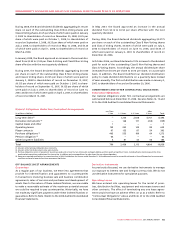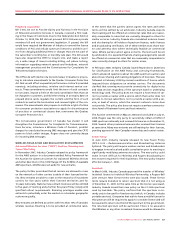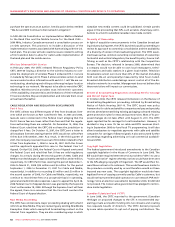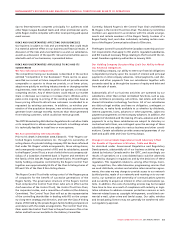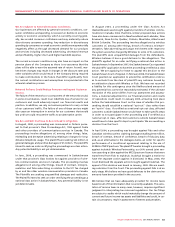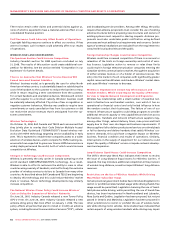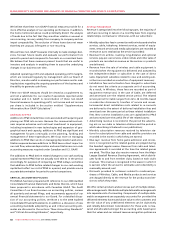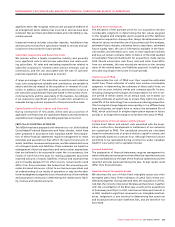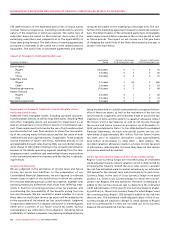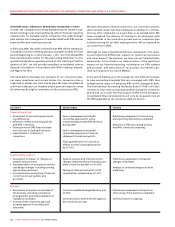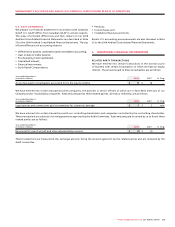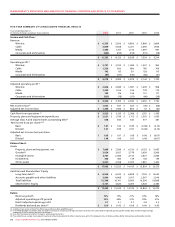Rogers 2008 Annual Report Download - page 69
Download and view the complete annual report
Please find page 69 of the 2008 Rogers annual report below. You can navigate through the pages in the report by either clicking on the pages listed below, or by using the keyword search tool below to find specific information within the annual report.
ROGERS COMMUNICATIONS INC. 2008 ANNUAL REPORT 65
MANAGEMENT’S DISCUSSION AND ANALYSIS OF FINANCIAL CONDITION AND RESULTS OF OPERATIONS
the attention of drivers in various circumstances, making accidents
more likely. Laws prohibiting or restricting the use of wireless hand-
sets while driving could have the effect of reducing subscriber
usage, which could cause an adverse effect on Wireless’ business.
Additionally, concerns over the use of wireless handsets while driving
could lead to litigation relating to accidents, deaths or bodily injuries,
which could also have an adverse effect on Wireless’ business.
Concerns About Radio Frequency Emissions May Adversely
Affect Our Business.
Occasionally, media and other reports have highlighted alleged
links between radio frequency emissions from wireless handsets
and various health concerns, including cancer, and interference
with various medical devices, including hearing aids and pacemak-
ers. While there are no definitive reports or studies stating that such
health issues are directly attributable to radio frequency emissions,
concerns over radio frequency emissions may discourage the use of
wireless handsets or expose us to potential litigation. It is also pos-
sible that future regulatory actions may result in the imposition of
more restrictive standards on radio frequency emissions from low
powered devices, such as wireless handsets. Wireless is unable to
predict the nature or extent of any such potential restrictions.
CABLE RISKS AND UNCERTAINTIES
Changes in Technology Could Increase Competition.
As improvements are made to the quality of streaming video over
the Internet, the availability of television shows and movies on the
Internet increases competition to Canadian cable television systems.
If changes in technology are made to any alternative Canadian
multi-channel broadcasting distribution system, competition with
our cable services may increase. In addition, if improvements in
technology are made with respect to wireless Internet, it could
increasingly become a substitute for the traditional high-speed
Internet service.
Failure to Obtain Access to Support Structures and Municipal
Rights of Way Could Increase Cable’s Costs and Adversely
Affect Our Business.
Cable requires access to support structures and municipal rights of
way in order to deploy facilities. Where access to municipal rights
of way cannot be secured, Cable may apply to the CRTC to obtain
a right of access under the Telecommunications Act. However, the
Supreme Court of Canada ruled in 2003 that the CRTC does not
have the jurisdiction to establish the terms and conditions of access
to the poles of hydroelectric companies. As a result of this decision,
Cable’s access to the poles of hydroelectric companies are obtained
pursuant to orders from the Ontario Energy Board and the New
Brunswick Public Utilities Board.
If Cable is Unable to Develop or Acquire Advanced
Encryption Technology to Prevent Unauthorized Access to Its
Programming, Cable Could Experience a Decline in Revenues.
Cable utilizes encryption technology to protect its cable signals from
unauthorized access and to control programming access based on
subscription packages. There can be no assurance that Cable will be
able to effectively prevent unauthorized decoding of signals in the
future. If Cable is unable to control cable access with our encryp-
tion technology, Cable’s subscription levels for digital programming
including VOD and SVOD, as well as Rogers Retail rentals, may
decline, which could result in a decline in Cable’s revenues.
Increasing Programming Costs Could Adversely Affect Cable’s
Results of Operations.
Cable’s single most significant purchasing commitment is the total
annual cost of acquiring programming. Programming costs have
increased significantly in recent years, particularly in connection
with the recent growth in subscriptions to digital specialty chan-
nels. Increasing programming costs within the industry could
adversely affect Cable’s operating results if Cable is unable to pass
such programming costs on to its subscribers.
Cable Telephony is Highly Dependent on Facilities and
Services of the ILECs.
Cable’s out-of-territory telephony business is highly-dependent on
the availability of unbundled facilities acquired from incumbent
telecom operators, pursuant to CRTC rules. Changes to these rules
could severely affect the cost of operating these businesses.
MEDIA RISKS AND UNCERTAINTIES
Changes in Regulatory Policies May Adversely Affect Media’s
Business.
In December 2006, the CRTC released its Commercial Radio Policy
2006. While Canadian talent development contributions made by
all radio stations will be increasing significantly, minimum Canadian
content levels will remain at 35%. This will provide radio operators
with the flexibility they need to program their stations in competi-
tion with an increasing array of unregulated content alternatives
and distribution platforms.
The CRTC conducted a review of the specialty and pay television
sector, as well as the regulations affecting all distributors (the
Broadcasting Distribution Regulations). This review focused on a
number of different issues, including wholesale fees, dispute reso-
lution and packaging and linkage requirements. This broad-based
review impacts all specialty services, including Rogers Sportsnet,
The Biography Channel Canada, OLN and G4TechTV Canada. See
the section entitled “Review of Broadcasting Regulations including
Fee-for-Carriage and Distant Signal Fees” above. The ability to col-
lect fees impacts all broadcasters, including OMNI Television and
Citytv.
Pressures Regarding Channel Placement Could Negatively
Impact the Tier Status of Certain of Media’s Channels.
Unfavourable channel placement could negatively affect the results
of The Shopping Channel, Sportsnet, G4TechTV, The Biography
Channel Canada and OLN.


